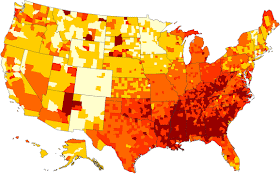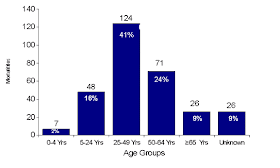Sunday, February 28, 2010
Brain Development
From http://www.joeallin.ca/early_years.html
By age 5, which of the following skills is in the least sensitive period? Hearing, Numbers, Emotional Control
Which skills are most sensitive at birth?
Which of the skills has its peak latest?
Saturday, February 27, 2010
Credit Card Loyalty
From http://www.creditcardfinder.com.au/australian-consumer-credit-card-banking-survey-2009.html
What percentage of people in this survey had had their credit card from 1-3 years?
Approximately how many people had had their credit card for 11 years or more?
What was the most frequent response?
What percentage of people in this survey had had their credit card from 1-3 years?
Approximately how many people had had their credit card for 11 years or more?
What was the most frequent response?
Friday, February 26, 2010
Snake Oil
From http://www.informationisbeautiful.net/play/snake-oil-supplements/ for full-size interactive version.
There is strong evidence that green tea can help with _____________________.
According to this chart, are ginseng or goji worth taking?
For which supplements is there strong evidence that they help with cholesterol?
Thursday, February 25, 2010
Asteroid Discoveries
From http://oklo.org/2006/04/
About how many asteroids were discovered in 1985? In 2000?
Why do you think that asteroid discovery might have peaked around the year 2000 and then declined?
About how many asteroids were discovered in 1985? In 2000?
Why do you think that asteroid discovery might have peaked around the year 2000 and then declined?
Wednesday, February 24, 2010
Asteroid Distance
From http://burro.astr.cwru.edu/stu/advanced/asteroid.html
About what distance from the Sun in A.U. is the greatest number of asteroids?
Are asteroids evenly distributed?
Approximately how many asteroids are there at 3.0 AU from the Sun?
Tuesday, February 23, 2010
Earthquake Energy
From http://www.americanthinker.com/blog/2008/06/cbs_pulls_unvetted_story_blami.html
What was the anueal energy release in earthquakes in 1905? 1920? 1980? 2000?
Describe the meaning of the black line and the red areas.
What was the anueal energy release in earthquakes in 1905? 1920? 1980? 2000?
Describe the meaning of the black line and the red areas.
Monday, February 22, 2010
Adult HIV prevalence in Africa between
What trend do you see over time?
Which countries have the greatest rates of HIV infection?
Uganda is one of the only countries that has been able to lower its rate of HIV infection. Can you find it on this map?
Sunday, February 21, 2010
Annual Deaths Attributable to Cigarette Smoking—United States, 2000–2004
From http://www.cdc.gov/tobacco/data_statistics/tables/health/attrdeaths/index.htm
How many deaths were there in this period from lung cancer?
How many deaths were there from stroke?
What are the leading causes of death for smokers?
How many deaths were there in this period from lung cancer?
How many deaths were there from stroke?
What are the leading causes of death for smokers?
Saturday, February 20, 2010
Lyme Disease Incidence Rates by State, 2004-2008*
From http://www.cdc.gov/ncidod/dvbid/lyme/ld_IncidenceRatesbyState20042008.htm
Use a chart or graph to represent some or all of the data. One way to start would be to only use states that had infections higher than 2.0.
Friday, February 19, 2010
Reported Cases of Lyme Disease by Year, United States, 1994-2008
From http://www.cdc.gov/ncidod/dvbid/lyme/ld_UpClimbLymeDis.htm
Describe the trend Lyme disease infections have been following.
When were some peaks of lyme disease outbreaks?
Describe the trend Lyme disease infections have been following.
When were some peaks of lyme disease outbreaks?
Thursday, February 18, 2010
2007 Age-Adjusted Estimates of the Percentage of Adults who are Obese
From http://apps.nccd.cdc.gov/DDT_STRS2/NationalDiabetesPrevalenceEstimates.aspx?mode=OBS
Which states have the highest rates of obesity?
Which states have the lowest rates of obesity?
Which states have no areas with rates higher than 27%?
Compare this map to yesterday's diabetes map. Where do you see correlation? Where do you see differences?
Wednesday, February 17, 2010
2007 Age-Adjusted Estimates of the Percentage of Adults with Diagnosed Diabetes
| |
From http://apps.nccd.cdc.gov/DDT_STRS2/NationalDiabetesPrevalenceEstimates.aspx?mode=DBT
Which states have the highest rates of diabetes?
Which states have the lowest rates of diabetes?
Compare Colorado to Florida.
Name 2 states that have no areas with rates higher than 8.8%
Tuesday, February 16, 2010
Deaths and Mortality
Look at the numbers below and make a graph or chart to show as much of the data as you can.
(Data are for the U.S.)
From http://www.cdc.gov/nchs/fastats/deaths.htm
(Data are for the U.S.)
- Number of deaths: 2,426,264
- Death rate: 810.4 deaths per 100,000 population
- Life expectancy: 77.7years
- Infant Mortality rate: 6.69 deaths per 1,000 live births
Number of deaths for leading causes of death:
- Heart disease: 631,636
- Cancer: 559,888
- Stroke (cerebrovascular diseases): 137,119
- Chronic lower respiratory diseases: 124,583
- Accidents (unintentional injuries): 121,599
- Diabetes: 72,449
- Alzheimer's disease: 72,432
- Influenza and Pneumonia: 56,326
- Nephritis, nephrotic syndrome, and nephrosis: 45,344
- Septicemia: 34,234
From http://www.cdc.gov/nchs/fastats/deaths.htm
Monday, February 15, 2010
Chronic Disease Indicators
Go here http://apps.nccd.cdc.gov/cdi/ and select two states and a category to compare. See what comes up, then make a graph or chart of the information you get. Here's an example I got comparing California and New York:
California compared with New York
California compared with New York
| Physical Activity and Nutrition | |||
| Indicator | Measure | California | New York |
|---|---|---|---|
| Fruit and vegetable consumption among adults aged >=18 years - 2007 view definition | Prevalence (CI) | 28.9% (27.3-30.5) | 27.4% (25.9-28.9) |
| Fruit and vegetable consumption among youth - 2007 view definition | Prevalence (CI) | - | - |
| Obesity among adults aged >= 18 years - 2007 view definition | Prevalence (CI) | 23.3% (21.7-24.9) | 25.5% (24.1-26.9) |
| Overweight or obesity among adults aged >= 18 years - 2007 view definition | Prevalence (CI) | 59.0% (57.2-60.8) | 62.0% (60.3-63.7) |
| Obesity among youth - 2007 view definition | Prevalence (CI) | - | 10.9% (9.9-12.1) |
| Recommended physical activity among adults aged >=18 years - 2007 view definition | Prevalence (CI) | 50.2% (48.3-52.1) | 48.9% (47.2-50.6) |
| Recommended physical activity among youth - 2007 view definition | Prevalence (CI) | - | 38.0% (35.8-40.2) |
| Television viewing among youth - 2007 view definition | Prevalence (CI) | - | 35.3% (32.3-38.5) |
Sunday, February 14, 2010
Cervical Cancer
Which group has the highest incidence of cervical cancer?
Which group has the highest rate of death from cervical cancer?
Which group has the lowest incidence of cervical cancer?
Saturday, February 13, 2010
Births and Natality
Make a graph to represent some or all of the following information:
- Number of births: 4,265,555
- Birth rate: 14.2 per 1,000 population
- Fertility rate: 68.5 births per 1000 women aged 15-44 years
- Percent born low birthweight: 8.3%
- Percent born preterm: 13%
- Percent unmarried: 38.5%
- Mean age at first birth: 25
Friday, February 12, 2010
Prevalence of Arthritis by Age/Race/Gender
Make a graph to represent the following information:
28.3 million women and 18.1 million men report doctor-diagnosed arthritis.
3.1 million Hispanic adults report doctor-diagnosed arthritis.
4.6 million Non-Hispanic Blacks report doctor diagnosed arthritis.
An estimated 294,000 children under age 18 have some form of arthritis or rheumatic condition, this represents approximately 1 in every 250 children.
From http://www.cdc.gov/arthritis/data_statistics/arthritis_related_stats.htm
Thursday, February 11, 2010
Prevalence of Specific Types of Arthritis
Make a graph to represent the following information:
The most common form of arthritis is osteoarthritis. Other common rheumatic conditions include gout, fibromyalgia and rheumatoid arthritis.
An estimated 27 million adults had osteoarthritis in 2005.
An estimated 1.3 million adults were affected by rheumatoid arthritis in 2005.
An estimated 3.0 million adults had gout in 2005, and 6.1 million adults have ever had gout.
An estimated 5.0 million adults had fibromyalgia in 2005.
The most common form of arthritis is osteoarthritis. Other common rheumatic conditions include gout, fibromyalgia and rheumatoid arthritis.
An estimated 27 million adults had osteoarthritis in 2005.
An estimated 1.3 million adults were affected by rheumatoid arthritis in 2005.
An estimated 3.0 million adults had gout in 2005, and 6.1 million adults have ever had gout.
An estimated 5.0 million adults had fibromyalgia in 2005.
Wednesday, February 10, 2010
Complete Tooth Loss Declines Among U.S. Adults Aged 65-74
What trend does this graph show?
In 1971, about what percent of Americans aged 65-74 had lost all of their teeth?
Tuesday, February 9, 2010
Calories of Grains
From http://www.versagrain.com/whole-grain-list.html
Which grain has the fewest calories?
The most?
How many calories does quinoa have per 1/4 cup?
Which grain has the fewest calories?
The most?
How many calories does quinoa have per 1/4 cup?
Monday, February 8, 2010
Houshold Expenses Over Time
In 1930, what was the greatest personal expense?
In 2007, what was the greatest personal expense?
In approximately which year did medical expenses overtake food expenses? Clothing and shoes?
Sunday, February 7, 2010
Marriage Happiness
Percentage Very Happy by Parental and Marital Status
Are the married or unmarried parents generally happier?
Of the unmarried parents, which are the least happy?
Of the married couples, which are most happy?
Saturday, February 6, 2010
California Maternal Mortality
Construct a graph to represent the following data from http://californiawatch.org/health-and-welfare/chart-tracking-maternal-mortality-rates
California’s maternal mortality rate has increased over an 11-year-period from 1996 through 2006, the most recent data available. The national maternal mortality rate was 13.3 per 100,000 in 2006.
California’s maternal mortality rate has increased over an 11-year-period from 1996 through 2006, the most recent data available. The national maternal mortality rate was 13.3 per 100,000 in 2006.
| Year | Rate per 100,000 | ||
| 1996 | 5.6 | ||
| 1997 | 9.1 | ||
| 1998 | 6.7 | ||
| 1999 | 7.7 | ||
| 2000 | 10.9 | ||
| 2001 | 9.7 | ||
| 2002 | 10.0 | ||
| 2003 | 14.6 | ||
| 2004 | 11.7 | ||
| 2005 | 11.7 | ||
| 2006 | 16.9 |
Friday, February 5, 2010
Chefs
Who is in charge of the kitchen?
Who is in charge of cheese in the morning?
Who is Emily Smith's direct supervisor?
How many people does Devin Knell supervise?
Thursday, February 4, 2010
H1N1 Mortalities by Age
From http://www.cdc.gov/H1N1FLU/surveillanceqa.htm
In which age group were H1N1 deaths most common?
In which age group were deaths least common?
Which age group made up about a quarter of the deaths?
In which age group were H1N1 deaths most common?
In which age group were deaths least common?
Which age group made up about a quarter of the deaths?
Wednesday, February 3, 2010
Allergy Graph
From http://www.understandingfoodadditives.org/pages/Ch5p2-2.htm
What is the most common allergy on this graph?
Out of 1000 people in the UK, how many have sensitivity to food additives according to this graph?
What occurs at a rate of 80/1000?
What is the most common allergy on this graph?
Out of 1000 people in the UK, how many have sensitivity to food additives according to this graph?
What occurs at a rate of 80/1000?
Tuesday, February 2, 2010
Sleep Graph
From http://www.knowabouthealth.com/sleep-deprivation-hinders-cognitive-functions/
Who tends to get more sleep? Men or women?
Do more men or women sleep 6 hours per night?
What is the most common number of hours slept per night in this study?
Who tends to get more sleep? Men or women?
Do more men or women sleep 6 hours per night?
What is the most common number of hours slept per night in this study?
Monday, February 1, 2010
Sleep Apnea
From http://www.vaughns-1-pagers.com/medicine/sleep-apnea.htm
How many breaths does the average sleeper take per minute?
How many breaths per minute does a person with sleep apnea take?
Which type of sleeper takes deeper breaths?




















